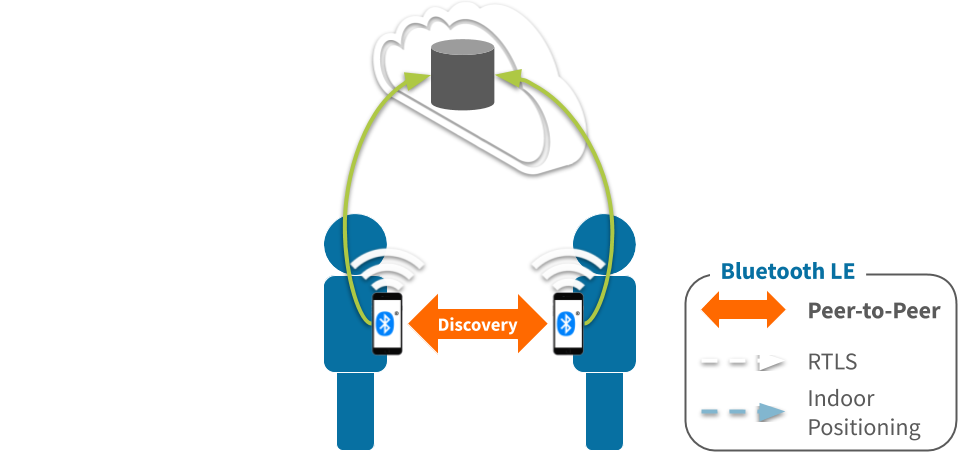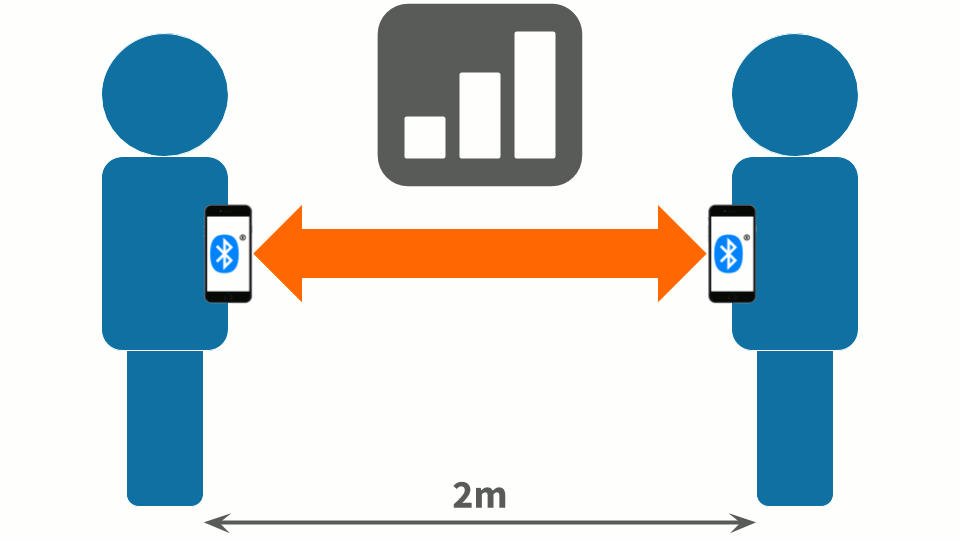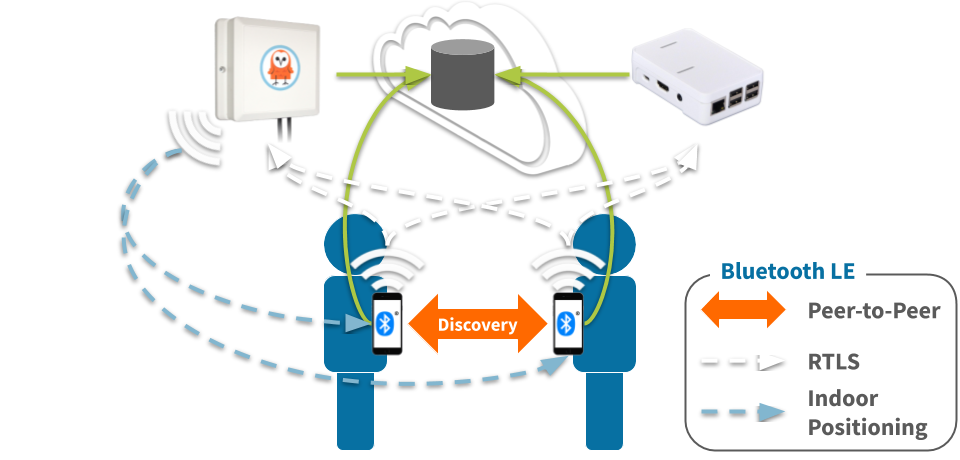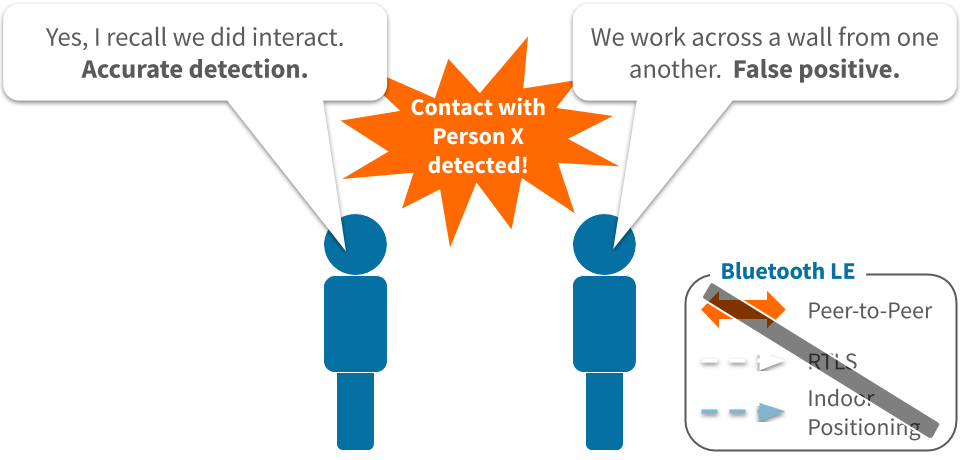Contact Tracing Architectures
An overview of architectures combining mobile, beacons, infrastructure and—most importantly—human judgement.

The TL;DR (Too Long; Didn't Read)
Discover, evaluate and compare various contact tracing architectures.
- What's contact tracing?
- Contact tracing is an attempt to determine all persons who interacted with an individual who tests positive for a contagious disease.
- What's the technology?
- This overview focuses on Bluetooth as it is the primary technology used in contact tracing initiatives during the COVID-19 pandemic.
- Why different architectures?
- There is no one-size-fits-all architecture, each has advantages and disadvantages, and they are stronger when combined.
Index of architectures
This overview is organised from the obvious to the perhaps-less-obvious architectures in four parts as follows:
- Part 1 of 4
-
Mobile peer-to-peer
There's an app for that. Actually many apps... - Part 2 of 4
-
Beacon peer-to-peer
Minus the mobile OS constraints. Minus the connectivity benefits. - Part 3 of 4
-
Add infrastructure
Collect real-time traces from physical spaces. - Part 4 of 4
-
Human judgement
More than just a fallback plan!
-
This overview is focused on Bluetooth-based architectures for discovery and connectivity only, and will refer to the remainder of the contact tracing implementation* simply as the traceability server.
* a topic strongly debated during the COVID-19 pandemic and well outside the scope of this document
Mobile peer-to-peer Part 1 of 4
There's an app for that. Oh wait, there are many apps for that...
- What's peer-to-peer?
- Each mobile device identifies and detects the proximity of its peers: other mobile devices.
- Any mobile device?
- Technically yes, any mobile device with Bluetooth 4 is capable. Practically no, as described below...

How it works
Mobile devices use Bluetooth LE for discovery, and their own Internet connectivity for traceability.
Peer-to-peer discovery
- mobile device periodically advertises (transmits) an identifier*
- mobile device periodically observes (receives) the identifiers of peers in range
- mobile device software estimates if an interaction occurred based on
- signal strength
- quantity and timing of decodings
* there is no single standard across implementations
Traceability
Mobile devices leverage their own Internet connectivity to periodically communicate with traceability servers to exchange information about the devices they discovered to determine if there was contact with an infected individual.*
* again, there is no single standard across implementations

The body is a barrier
Water molecules in the human body readily absorb Bluetooth and other 2.4GHz signals, preventing reliable ranging of mobile devices based on signal strength alone.
False positives are an inevitable result of this unavoidable physical constraint.
- Ubiquity of mobile devices
- Speed and ease of mobile app penetration
- Reliable peer-to-peer discovery favours device worn on chest
- Mobile OS constraints severely limit functionality
Dive into the details
Learn more about the underlying technology and constraints:
-

Best practices for BLE identifers: Platform and OS constraints
Assignment of Bluetooth Low Energy (BLE) identifiers for interoperability and interpretability
Beacon peer-to-peer Part 2 of 4
Freedom from the mobile OS constraints, but without the mobile connectivity benefits.
- What's peer-to-peer?
- Each beacon identifies and detects the proximity of its peers: other beacons.
- Any beacon?
- Any Bluetooth beacon that can be programmed with contact tracing software will be compatible with others programmed alike.
How it works
Beacons use Bluetooth LE for discovery. Connectivity for traceability varies.
Peer-to-peer discovery
- beacon periodically advertises (transmits) an identifier*
- beacon periodically observes (receives) the identifiers of peers in range
- beacon software estimates if an interaction occurred based on
- signal strength
- quantity and timing of decodings
* there is no single standard across implementations
Traceability
A typical beacon does not have its own means of Internet connectivity and must therefore rely on an intermediary such as:
- a paired mobile application
- an implementation-specific hub or gateway
- Many off-the-shelf chest-mounted badges and lanyard beacons which offer optimal peer-to-peer discovery
- Can provide visual and/or haptic feedback to the user
- External dependence on connectivity is a point of failure
- Requires regular battery maintenance (charging/replacement)
Mobile-beacon hybrid architecture
Mobile devices and beacons can discover one another too
Add infrastructure Part 3 of 4
Enable physical spaces to collect real-time traces.
- What's infrastructure?
- Any Bluetooth receiver with network connectivity can act as gateway infrastructure.
- Any infrastructure?
- Yes, provided the Bluetooth gateway can run software to receive and forward contact tracing packets.
Beacons and infrastructure
Adds real-time connectivity for both interaction detection and location.
What the infrastucture adds for the physical space
Real-time location: traceability of where individuals are (and were) within the physical space.
- gateways observe (receive) the identifiers of beacons in range
- gateways forward the real-time data to the traceability server
- software on the traceability server estimates the real-time location* of each beacon based on its relative signal strength on each gateway
* insufficient granularity to reliably estimate <2m interactions alone, nonetheless sufficient for journey/heatmapping
What the infrastucture adds for the beacon
Real-time connectivity: each beacon can forward its real-time interactions via the infrastructure.
- beacon periodically observes (receives) the identifiers of peers in range
- beacon software estimates if an interaction occurred based on
- signal strength
- quantity and timing of decodings
- beacon advertises (transmits) its identifier and the identifiers of any peers in close proximity
Example: DirAct
DirAct is software for Bluetooth beacons which observes what's in proximity and advertises this data for any device in range to interpret.
- Beacon data is available in real-time
- Infrastructure enables many other complementary use cases beyond contact tracing
- Additional cost & complexity of solution
Mobile and infrastructure
Adds real-time location and indoor positioning in the physical space itself.

What the infrastucture adds for the physical space
Real-time location: traceability of where individuals are (and were) within the physical space.
- gateways observe (receive) the identifiers of mobile devices in range
- gateways forward the real-time data to the traceability server
- software on the traceability server estimates the real-time location* of each mobile based on its relative signal strength on each gateway
* insufficient granularity to reliably estimate <2m interactions alone, nonetheless sufficient for journey/heatmapping
What the infrastucture adds for the mobile device
Indoor positioning: mobile devices can estimate where they themselves are (and were) within the physical space.
- mobile device observes (receive) the identifiers of gateways in range
- mobile device uses an indoor positioning service (IPS) to estimate its own position* based on the signal strength and known location of each gateway
- mobile device relays its position to the traceability server
* insufficient granularity to reliably estimate <2m interactions alone, nonetheless sufficient for journey mapping
Example: Physical Web (2017)
This video demonstrates mobile peer-to-peer discovery as well as discovery by infrastructure through innovative use of Google's Physical Web project during the time it was active.
The underlying Bluetooth discovery mechanism is the same as for contact tracing, and the challenges of overcoming mobile OS contraints remain.
- RTLS and IPS data can mitigate the peer-to-peer detection limitiations of mobile
- Infrastructure enables many other complementary use cases beyond contact tracing
- Additional cost & complexity of solution
- Potential privacy concerns over the association of an interaction with a specific location
Mobile, beacon and infrastructure
Robust interaction detection and location facilitated by the interoperability of Bluetooth LE.
Example: Contact Tracing service
Apple & Google have collaborated to create a Contact Tracing service for mobile, and in the video we demonstrate the utility of infrastructure in addition to open source testing tools using off-the-shelf beacons.
This is what we call Hyperlocal Context
This architecture highlights the largely untapped potential of ubiquitous and standardised radio-frequency identification which is foundational to our vision at reelyActive. Learn more:
-

Enabling computers to understand who/what is where/how...
...in any physical space, and without the need for human-entered data. -

Towards collective hyperlocal contextual awareness among heterogeneous RFID systems
Published at 3rd IEEE Conference on Internet of People (IoP 2017) | Fremont, CA. August 4-8, 2017
Human judgement Part 4 of 4
More than just a fallback plan!
- Why a human element?
- Humans are already very good at contact tracing. Technology simply serves to augment their abilities.
- So the tech isn't perfect?
- Of course not! Even a well-executed solution will produce edge cases best resolved with human judgement.

- User feedback enables continuous improvement of the underlying technology
- Do you recall everyone with whom you interacted over a given period?

Embrace the ambient data in your space
Pareto Anywhere is pioneering open source software for real-time location and context.
Where to next?
Continue exploring our open architecture and all its applications.
-

Best practices for Bluetooth LE identifiers
Assignment of Bluetooth Low Energy (BLE) identifiers for interoperability and interpretability. -

DirAct
Proximity interaction detection software for Bluetooth beacons. -

Additional use cases of infrastructure
All the use cases of Pareto Anywhere open source software by reelyActive. -

diyActive Home
The home for reelyActive developers.